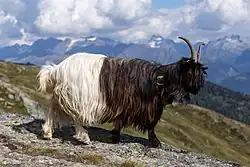Valais Blackneck
 | |
 | |
| Conservation status | |
|---|---|
| Other names |
|
| Country of origin | |
| Distribution | mainly in the Valais |
| Standard | |
| Use | |
| Traits | |
| Weight | |
| Height | |
| Skin colour | often pale |
| Coat | black foreparts, white hindparts |
| Hair colour | black, white |
| Face colour | black |
| Horn status | horned in both sexes |
| |

The Valais Blackneck is a Swiss breed of domestic goat from the canton of Valais. It has a distinctive colouring, black from the nose to behind the shoulder and white from there to the tail.
It is distributed in southern Switzerland – the largest concentration is in the area of Visp (Viège) – and in neighbouring areas of northern Italy; it is present in modest numbers in Austria and Germany. It is known by many names, including German: Walliser Schwarzhalsziege or Gletschergeiss; French: Col Noir du Valais, Chèvre des Glaciers or Race de Viège; and Italian: Vallesana or Vallese.
History
The Walliser Schwarzhalsziege is a traditional breed of the Swiss canton of Valais. A herd-book was established in 1920.[5]
Within Italy, the Vallesana is raised in the provinces of Verbania and Vercelli.[8] It is one of the forty-three autochthonous Italian goat breeds of limited distribution for which a herd-book is kept by the Associazione Nazionale della Pastorizia, the Italian national association of sheep- and goat-breeders.[9][10]
At the end of 2013 the total numbers for the breed were 3000–3400 in Switzerland and either 191[11] or 446[4] in Italy. In 2012 Austria reported 100–300 head[2] and Germany 429.[3]
Characteristics
The Valais Blackneck is of medium size; nannies stand on average 75 cm at the withers, with a body weight of at least 55 kg, billies are on average about 10 cm taller and weigh no less than 75 kg.[7] The colouring of the coat is distinctive: coal black from the nose to behind the shoulder and snow white from there to the tail; the division between the two colours is clearly defined, and should be within ±3 cm of the point where the last rib meets the spine.[12] The fore hooves are black, the hind ones pale.[12] The coat hair is long and the skin is fine;[12] horns are present in both sexes, as is a black beard; the horns are larger in billies.[7]
The English Bagot is similarly coloured, and has been thought to derive from this breed by descent from one presented to Richard II of England in 1387;[13]: 420 DNA studies have shown that the Bagot originated in Spain.[14]: 360
Use
The Valais Blackneck is reared principally for its meat;[14]: 415 it is not usually milked.[15] The milk yield is approximately 500 kg per lactation.[14]: 415 The pelts may be used to make leather goods.[14]: 360
The goats are also used for vegetation management: they move freely on steep mountain terrain, which they help to keep clear of excess scrub vegetation.[12][5]
References
- ^ a b c Barbara Rischkowsky, Dafydd Pilling (editors) (2007). List of breeds documented in the Global Databank for Animal Genetic Resources, annex to: The State of the World's Animal Genetic Resources for Food and Agriculture. Rome: Commission on Genetic Resources for Food and Agriculture, Food and Agriculture Organization of the United Nations. ISBN 9789251057629. Archived 23 June 2020.
- ^ a b c d Breed data sheet: Walliser Schwarzhalsziege / Austria (Goat). Domestic Animal Diversity Information System of the Food and Agriculture Organization of the United Nations. Accessed July 2025.
- ^ a b c Breed data sheet: Walliser Schwarzhals-Ziege / Germany (Goat). Domestic Animal Diversity Information System of the Food and Agriculture Organization of the United Nations. Accessed July 2025.
- ^ a b c Breed data sheet: Vallesana/Italy. Domestic Animal Diversity Information System of the Food and Agriculture Organization of the United Nations. Accessed July 2025.
- ^ a b c Breed data sheet: Walliser Schwarzhalsziege / Switzerland (Goat). Domestic Animal Diversity Information System of the Food and Agriculture Organization of the United Nations. Accessed July 2025.
- ^ Transboundary breed: Valais Blackneck. Domestic Animal Diversity Information System of the Food and Agriculture Organization of the United Nations. Accessed July 2025.
- ^ a b c d e f Walliser Schwarzhaslziege (in German). Oberwalliser Ziegenzuchtverband. Archived 14 May 2021.
- ^ Norme tecniche della popolazione caprina "Capra Vallesana": standard della razza (in Italian). Associazione Nazionale della Pastorizia. Archived 23 September 2015.
- ^ Strutture Zootecniche (Dec. 2009/712/CE - Allegato 2 - Capitolo 2) (in Italian). Ministero delle Politiche Agricole Alimentari e Forestali. Section I (e). Archived 4 May 2014.
- ^ Le razze ovine e caprine in Italia (in Italian). Associazione Nazionale della Pastorizia: Ufficio centrale libri genealogici e registri anagrafici razze ovine e caprine. Archived 21 September 2013.
- ^ Consistenze Provinciali della Razza 92 Vallesana Anno 2013 (in Italian). Associazione Nazionale della Pastorizia: Banca dati. Archived 3 March 2016.
- ^ a b c d Walliser Schwarzhalsziege (7) (in German). Zollikofen: Schweizerischer Ziegenzuchtverband/Fédération suisse d'élevage caprin/Federazione svizzera d'allevamento caprino. Archived 11 February 2025.
- ^ Daniele Bigi, Alessio Zanon (2008). Atlante delle razze autoctone: Bovini, equini, ovicaprini, suini allevati in Italia (in Italian). Milan: Edagricole. ISBN 9788850652594.
- ^ a b c d Valerie Porter, Lawrence Alderson, Stephen J.G. Hall, D. Phillip Sponenberg (2016). Mason's World Encyclopedia of Livestock Breeds and Breeding (sixth edition). Wallingford: CABI. ISBN 9781780647944.
- ^ Walliser Schwarzhalsziege (in German). Zollikofen: Schweizerischer Ziegenzuchtverband/Fédération suisse d'élevage caprin/Federazione svizzera d'allevamento caprino. Archived 28 April 2025.